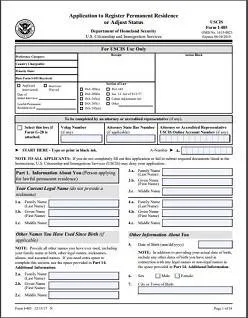TOP 5 MISTAKES PEOPLE MAKE WHEN FILING FOR ADJUSTMENT OF STATUS

uscis case status wrong update
IT NEVER FAILS – every year I meet with clients who are seeking help for a case they already filed with U.S. Citizenship and Immigration Services (USCIS) that ended up stuck because they were asked for additional information, the filing was completely rejected, or the case was denied. The majority of those people can be helped but, in some cases, I have had to advise them NOT to continue with their case to avoid possible trouble with immigration officials.
Applications made to USCIS usually do not require hiring at attorney, and many people do choose to file their applications on their own. However, no two immigration application processes are alike, and even people in similar situations may be processed differently depending on a variety of factors in their history. There are so many forms and different types of evidence required when applying for immigration benefits that it’s easy to understand how people make mistakes when they file on their own. Below are some of the most common mistakes and problems I see when people come to me after filing a case using I-485 Application to Register Permanent Residence or Adjust Status (getting a green card):
- Filing for Adjustment of Status When You Don’t Qualify. This one is actually quite common. Many people do not realize that you must meet a very particular set of requirements to be eligible to file an Adjustment of Status. For example, if you are filing through marriage, the most important requirements are proving that you entered the country legally and that your spouse is a U.S. citizen. While there are a few exceptions to these rules that may qualify you to apply anyway (like having a military spouse), most people do not know how to properly evaluate if they fall into the category of people who qualify to file this application.
- Filing Without Required Evidence. Even people who do qualify to file their case often file without including all of the evidence that USCIS needs to see before accepting or approving an application. Insufficient proof of a required relationship, no proof of entry to the United States, missing financial documents, or even a U.S. citizen lacking proof of their citizenship are just a few of the reasons your case may be rejected or denied.
- Filing Incomplete Applications. As I mentioned above, the process of filing for a green card is actually pretty complex when you realize that it takes more than just filing a form or two to even get the application accepted for processing. Often people will leave out important forms or important information simply because they are not aware it is required. There are several pages to each form with MANY questions to answer. Leaving certain questions blank or answering them incorrectly can cost you if you file your applications this way.
- Filing Without Correct Filing Fees. The filing fees for an Adjustment of Status are usually pretty straight forward. However, depending on how you are qualifying for Adjustment, your fees can vary. Many people also forget to include the biometric (fingerprint) fee with their application. It is important to make sure that if you are also filing a petition at the same time that the appropriate petition fee is included. If you send out an application with incorrect fees, your case will be rejected and sent back to you.
- Filing with a Criminal Record or Negative Immigration Record. This one is the one that is the scariest. Depending on the severity of what is in a client’s criminal or immigration history, they may not only have their case denied but also risk being placed in deportation proceedings. Fortunately, there are criminal and immigration infractions that can be “waived” so an applicant may still qualify, but it is extremely important that you find this out before you ever send out an application to USCIS. Get copies of your criminal record and have them reviewed by an experienced immigration attorney if you want to file for your green card.
While in most cases, mistakes made in filings can be fixed, there are some errors people can make that are fatal to their cases and their immigration status. Even clients with cases that can be fixed find themselves spending way more time and money on making things right than if the case had been properly filed from the start.
Are you or someone you know thinking about filing for their green card? Talk to an experienced attorney to discuss your situation and help you file your case without all of the risks of filing alone. Contact my office today at (210) 320-5633 to set up a consultation and get a professional assessment of your case.
 IT NEVER FAILS – every year I meet with clients who are seeking help for a case they already filed with U.S. Citizenship and Immigration Services (USCIS) that ended up stuck because they were asked for additional information, the filing was completely rejected, or the case was denied. The majority of those people can be helped but, in some cases, I have had to advise them NOT to continue with their case to avoid possible trouble with immigration officials.
IT NEVER FAILS – every year I meet with clients who are seeking help for a case they already filed with U.S. Citizenship and Immigration Services (USCIS) that ended up stuck because they were asked for additional information, the filing was completely rejected, or the case was denied. The majority of those people can be helped but, in some cases, I have had to advise them NOT to continue with their case to avoid possible trouble with immigration officials.
Applications made to USCIS usually do not require hiring at attorney, and many people do choose to file their applications on their own. However, no two immigration application processes are alike, and even people in similar situations may be processed differently depending on a variety of factors in their history. There are so many forms and different types of evidence required when applying for immigration benefits that it’s easy to understand how people make mistakes when they file on their own. Below are some of the most common mistakes and problems I see when people come to me after filing a case using I-485 Application to Register Permanent Residence or Adjust Status (getting a green card):
- Filing for Adjustment of Status When You Don’t Qualify. This one is actually quite common. Many people do not realize that you must meet a very particular set of requirements to be eligible to file an Adjustment of Status. For example, if you are filing through marriage, the most important requirements are proving that you entered the country legally and that your spouse is a U.S. citizen. While there are a few exceptions to these rules that may qualify you to apply anyway (like having a military spouse), most people do not know how to properly evaluate if they fall into the category of people who qualify to file this application.
- Filing Without Required Evidence. Even people who do qualify to file their case often file without including all of the evidence that USCIS needs to see before accepting or approving an application. Insufficient proof of a required relationship, no proof of entry to the United States, missing financial documents, or even a U.S. citizen lacking proof of their citizenship are just a few of the reasons your case may be rejected or denied.
- Filing Incomplete Applications. As I mentioned above, the process of filing for a green card is actually pretty complex when you realize that it takes more than just filing a form or two to even get the application accepted for processing. Often people will leave out important forms or important information simply because they are not aware it is required. There are several pages to each form with MANY questions to answer. Leaving certain questions blank or answering them incorrectly can cost you if you file your applications this way.
- Filing Without Correct Filing Fees. The filing fees for an Adjustment of Status are usually pretty straight forward. However, depending on how you are qualifying for Adjustment, your fees can vary. Many people also forget to include the biometric (fingerprint) fee with their application. It is important to make sure that if you are also filing a petition at the same time that the appropriate petition fee is included. If you send out an application with incorrect fees, your case will be rejected and sent back to you.
- Filing with a Criminal Record or Negative Immigration Record. This one is the one that is the scariest. Depending on the severity of what is in a client’s criminal or immigration history, they may not only have their case denied but also risk being placed in deportation proceedings. Fortunately, there are criminal and immigration infractions that can be “waived” so an applicant may still qualify, but it is extremely important that you find this out before you ever send out an application to USCIS. Get copies of your criminal record and have them reviewed by an experienced immigration attorney if you want to file for your green card.
While in most cases, mistakes made in filings can be fixed, there are some errors people can make that are fatal to their cases and their immigration status. Even clients with cases that can be fixed find themselves spending way more time and money on making things right than if the case had been properly filed from the start.
Are you or someone you know thinking about filing for their green card? Talk to an experienced attorney to discuss your situation and help you file your case without all of the risks of filing alone. Contact my office today at (210) 320-5633 to set up a consultation and get a professional assessment of your case.
